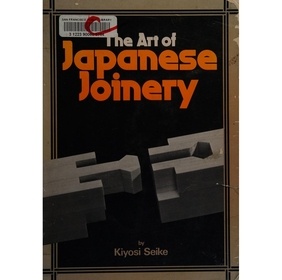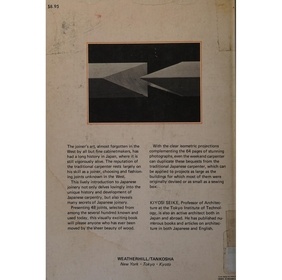Contenu
With the clear isometric projections complementing the 64 pages of stunning photographs, even the weekend carpenter can duplicate these bequests from the traditional Japanese carpenter, which can be applied to projects as large as the buildings for which most of them were originally devised or to projects as small as a sewing box.
Where Wood Has a Soul. 11
Wooden Structures. 13
Kiware: Construction Proportions. 14
Space. 16
Carpenter's Dōgu, or Instruments. 17
The Roof Truss. 20
Framework and Floor Framing. 23
2. Functions of Japanese Joinery
Wood Constructions. 89
Splicing and Connecting Joints. 92
Groundsills, Posts, and Joinery. 93
The Roof. 95
Bracing. 96
3. Tsugite: Splicing Joints.
Sogi-tsugi, the Simple Scarf Joint. 99
Koshikake-tsugi, the Lap Joint. 100
Ari-tsugi, the Dovetail Joint. 100
Mechigai-tsugi, the Stub Mortise and Tenon. 101
Hagi-tsugi, Board Jointing. 102
Kama-tsugi, the Gooseneck Mortise and Tenon. 103
Sao-tsugi, the Lapped Rod Mortise and Tenon. 105
Daimochi-tsugi, the Oblique Scarf Joint with Stub Tenon. 106
Okkake-daisen-tsugi, the Rabbeted Oblique Scarf Joint. 106
Kanawa-tsugi, the Mortised Rabbeted Oblique Scarf Joint. 107
Isuka-tsugi, the Halved rabbeted Oblique Scarf Joint. 108
Kakushi-mechigai-tsugi, the Half Blind Stub Tenon. 110
4. Shiguchi: Connecting Joints
Ai-jakuri, the End Lap Joint. 113
Wanagi-komi, the Open Slot Mortise with Whole-Timber Tenon. 114
Ō-dome, the Miteered Open Mortise. 114
Hira-hozo, the True Mortise and Tenon. 116
Hana-sen, the External Draw Pin Joint. 117
Wari-kusabi, the Split Wedge Joint. 118
Sage-kama, the Wedged Through Half Dovetail Joint. 119
Ari-otoshi, the Housed Dovetail Joint. 120
Ōire, the Beveled Shoulder Mortise and Tenon. 122
Ai-gaki, the Cross Lap Joint. 124
Complex Joints. 125
Détails
1 critique
Intéressant pour son approche historique et contextuelle des assemblages japonais. La moitié du livre y est consacrée. L'autre décrit une petite sélection d'assemblages (à peine plus de 20). L'ensemble est intéressant, mais le livre péche vraiment par sa mise en page.
Impossible de trouver rapidement un assemblage, ses caractéristiques structurelles, ni même sa photo (qui sont toutes réunies au milieu du livre : il faut sans cesse faire des allers-retours entre la page de description et celle de sa photo).
L'objectif du livre n'est pas non plus de montrer comment faire les-dits joints, aucun détails sur leur mise en œuvre.
Si comme moi vous cherchez un livre pour savoir quel assemblage choisir dans quels cas, en fonction de ses caractéristiques, et comment le réaliser, ce livre n'est pas le bon.
Vous n'êtes pas autorisé à indiquer votre accord ou désaccord vos propres contributions.
L'adresse e-mail associée à votre compte doit être confirmée avant de pouvoir indiquer votre accord ou désaccord.



Discussions